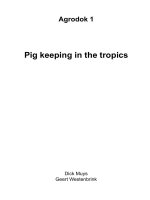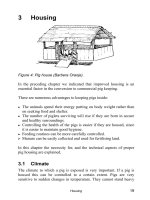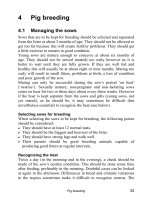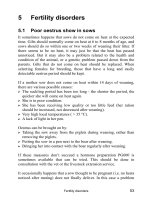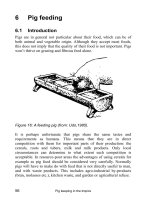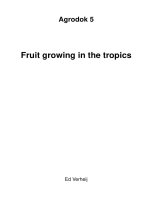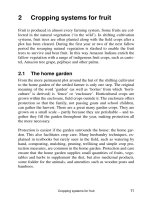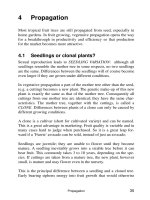Erosion control in the tropics - Part 1 doc
Bạn đang xem bản rút gọn của tài liệu. Xem và tải ngay bản đầy đủ của tài liệu tại đây (129.13 KB, 9 trang )
Agrodok 11
Erosion control in the
tropics
Hil Kuypers
Anne Mollema
Egger Topper
© Agromisa Foundation, Wageningen, 2005.
A
ll rights reserved. No part of this book may be reproduced in any form, by print, photocopy,
microfilm or any other means, without written permission from the publisher.
First edition: 1983
Fourth revised edition: 1999
Sixth edition: 2005
A
uthors: Hil Kuypers, Anne Mollema, Egger Topper
Translation: P. Verhei
Printed by: Digigrafi, Wageningen, The Netherlands.
ISBN: 90-8573-013-9
NUGI: 835
Foreword 3
Foreword
Foreword to second revised edition
This is a revised version of the first edition of this Agrodok. Hopefully
it is a useful introduction to the erosion problem and its control. We
want to thank Mr. Eppink from the Agricultural University of Wagen-
ingen for his remarks and corrections, and Hensen Trenning for the
illustrations.
The authors,
Hil Kuypers
Anne Mollema
Egger Topper
Wageningen, 1987
Foreword to the fourth revised edition
We have experienced that this Agrodok on Erosion control is quite
popular. Due to this we have to reprint regularly. For this fourth edi-
tion we have improved the layout and the pictures, and incorporated
improvements in the text.
We are very grateful to Arend Kortenhorst who has taken care of the
lay out with great patience and a good eye for details.
Agromisa welcomes readers to send us suggestions which could help
us to improve the contents of the publication.
Marg Leijdens
Coordinator Agrodok Publications
Wageningen, 1999
Erosion control in the tropics 4
Contents
1 Introduction 6
1.1 Objectives of this Agrodok 6
1.2 What is soil erosion 7
1.3 The seriousness of the erosion problem 8
2 How to recognize erosion 10
2.1 Symptoms of erosion 10
2.2 Other ways to discover erosion 14
2.3 Symptoms of degeneration of the environment 15
3 The erosion process 17
3.1 Splash-erosion and stream-erosion 17
3.2 Splash-erosion and soil condition 19
3.3 Stream erosion and the soil 21
3.4 An example on how to show the erosion process 23
3.5 The principles of measures against erosion 24
4 How erosion effects agriculture 26
4.1 Consequences for the soil 26
4.2 Consequences for farm management 27
5 Agronomic methods to control erosion 30
5.1 Contour farming 31
5.2 Strip cropping and strip reclamation 34
5.3 Limitation of tillage 37
5.4 Mulching and stubble mulching 39
5.5 Cover crops 42
5.6 Fertilizing 44
5.7 Multiple cropping 46
6 Using cropping systems to control erosion 48
6.1 Rotation and fallow 48
6.2 Grassland and fires 50
Contents 5
6.3 Trees and woodland against erosion 52
7 Measures to reduce runoff 56
7.1 Different levels of measures 56
7.2 Barriers to reduce the speed of running water 59
7.3 Terraces 60
7.4 Drainage 65
7.5 Gully control 67
7.6 General remarks for technical measures 71
8 Underlying causes of erosion 73
9 Conditions for the success of operations 75
9.1 Trust 75
9.2 Awareness 76
9.3 Correct choice of operations 76
10 Conclusion 79
Appendix 1: Several techniques for levelling and
measuring heights 82
Appendix 2: Tree species for erosion control in the tropics
and sub-tropics 87
Appendix 3: Legumes; characteristics and utilization 90
Further reading 92
Glossary 94
Erosion control in the tropics 6
1 Introduction
Agromisa’s Question and Answer Service receives many questions
about erosion and its control. In reply to the very specific questions,
an equally direct answer can usually be given. However, general ques-
tions come in as well, such as: “What can be done against erosion in
this area?”. Obviously, such a question can only be answered if a
number of counter-questions are asked, for example:
? What are the erosion characteristics?
? What is the rainfall distribution?
? What sort of crops are grown there?
? Are you situated in a hilly area?
? etc.
Only then would we be able to give the most important facts about
soil conservation. This Agrodok may be considered as an extensive
reply to such questions. At the same time it is an introduction to ero-
sion control.
With only this booklet at hand, you will not be in a position to lay out
a number of terraces straight away; for this, other books are available
(see the section ‘Further Reading’). Yet, we have tried to write a book
which will be useful for people who are confronted with the practical
aspects of erosion.
1.1 Objectives of this Agrodok
In compiling the booklet we have kept the following objectives in
mind:
? To emphasize the seriousness of the erosion problem. Erosion is not
always recognized in time, and certainly not when it takes place
surreptitiously.
? To give an insight into the causes and the course of the erosion
process, by stating the factors which influence the mechanism of
erosion and how these factors are linked up.
Introduction 7
? To clarify the relation between erosion and the farming system. The
farming system (land-use) largely determines whether erosion will
occur; erosion in its turn again imposes limitations on agriculture.
? To enumerate the most important soil conservation measures and
the principles on which they are based, at the same time indicating
how they can be applied. How erosion can be prevented will be dis-
cussed at length here too.
For clarity, we have restricted ourselves to erosion caused by water. In
doing so, the connection between the causes of erosion and the princi-
ples of erosion control measures will always be kept in mind. The so-
called mass movements (earthquakes, mud streams etc.) will also be
discussed briefly because these phenomena are often related to water
erosion and the causes of it. The seriousness of wind erosion cannot be
underestimated but this is beyond the scope of this booklet.
To keep this booklet accessible for everybody we have not assumed a
previous knowledge. Therefore, you may well read things you already
know. Some technical terms will have to be used too, necessary to
prevent misunderstandings. The same terms will crop up anyway
when reading other literature. The explanation or the definition of the
relevant difficult terms can be found in the Glossary in the back.
If you find it difficult to get an overview of all the information, you
could refer to Chapter 10 in which the connection between the various
chapters is briefly given.
1.2 What is soil erosion
Since there are several different definitions of erosion, we will first
clarify what we mean by erosion here. There are really two types of
erosion, natural and accelerated erosion, also called man-made ero-
sion.
? Natural erosion is going on all the time; the weathering of moun-
tains, hills etc. caused by the influences of nature. New landscapes
are formed, but the process is very slow.
Erosion control in the tropics 8
? Man-made erosion occurs when people cause the soil to become
susceptible to be carried away by rain or wind. Cutting trees and
burning vegetation are examples of practices that destroy the natural
protection of the soil. This book is about man-made water erosion.
Another important factor is soil degradation, that is the decline of soil
quality as a consequence of people using the land. Soil degradation
and erosion overlap. Soil degradation is a wider term, erosion being
but one form of soil degradation, others are: pollution, salination, etc.
1.3 The seriousness of the erosion problem
Every minute, an estimated 10 hectares of agricultural land is lost to
erosion throughout the world. In some areas, very little occurs, in oth-
ers more than 200 tons of soil disappears every year from 1 hec-
tare (i.e. 20 lorry loads!). On average about 50 tons of soil per hec-
tare are lost each year. The soil lost is the top layer, which is the most
fertile part of the soil.
The rivers in which these soils are transported change into a brown
gushing stream in the rainy season. They occasionally flood the low
lying areas. The fish in these rivers are at the mercy of that dirty water.
If the water is used for irrigation, then ditches silt up, at best mainte-
nance costs rise alarmingly. Sometimes all the soil ends up in a dam
reservoir, as in the Shinen reservoir in Taiwan for example, which was
half full of silt within five years, whereas a life duration of 70 years
had been estimated.
These problems could be fatal and forces the governments to face up
to the seriousness of the erosion problem. A government can oblige
farmers to carry out erosion control (soil conservation) measures as
reafforestation and terracing. The farmers should then be compensated
with loans in these schemes. Many farmers are so badly in need of
their plot of land that any restricting regulation would mean starva-
tion.
Introduction 9
If the threat of erosion is not yet as fatal as mentioned above, individ-
ual farmers or groups of farmers can carry out erosion control meas-
ures in order to protect their land and food security.
It seems that the seriousness of the erosion problem can be measured
by the amount of soil lost from one hectare. This is not always so sim-
ple. Especially in hilly areas the depth of the fertile top soil may vary
considerably from one place to another within short distances. There is
no cause for alarm if the depth of soil is a few meters, but if there are
only a few centimetres before reaching the subsoil or bare rocks, this
must be safeguarded at all cost.
It can be concluded that the seriousness of the erosion problem differs
not only on a worldwide scale, but locally as well. For two farmers
living on the same mountain slope, the situation may be quite differ-
ent. It is usually the poorest section of the community that is hardest
hit by the effects of erosion. In the light of this, it is not surprising that
in the U.N. report of 1984, erosion is considered to be the greatest
threat to mankind.

